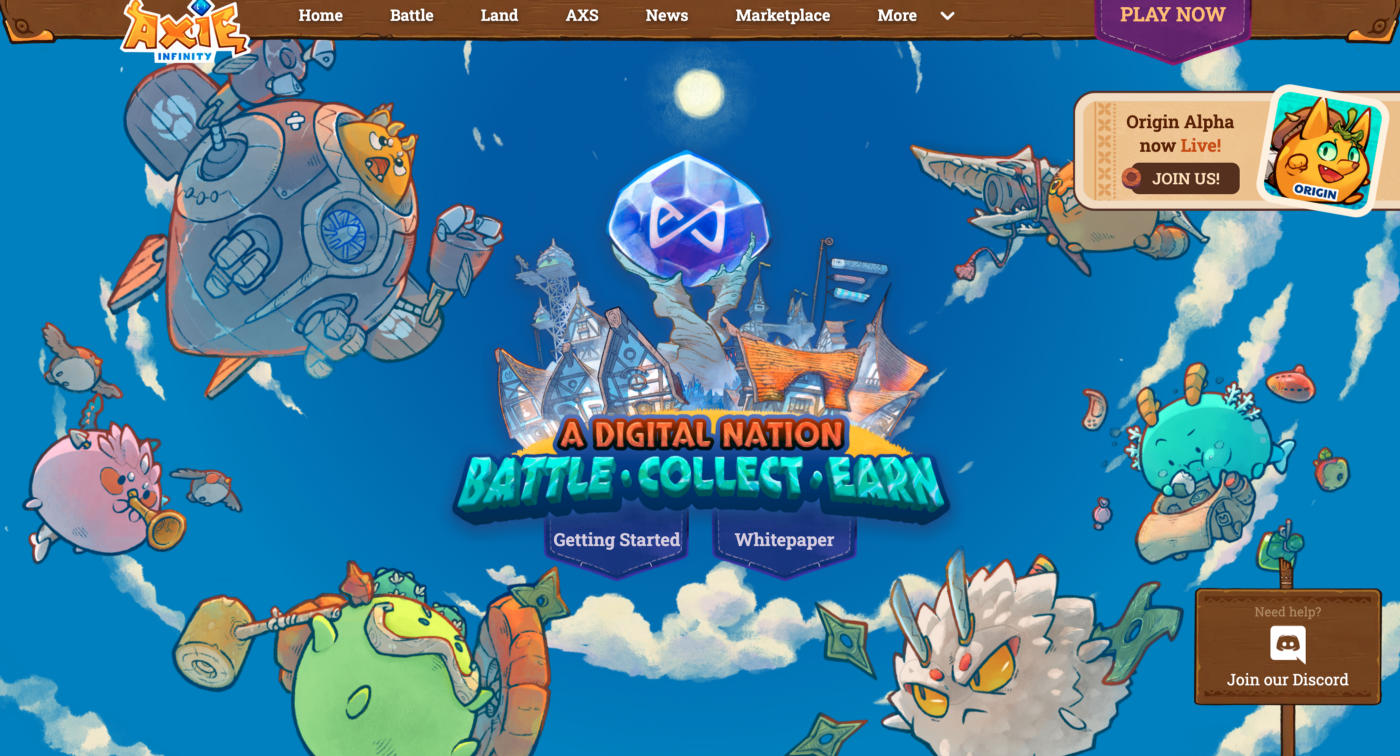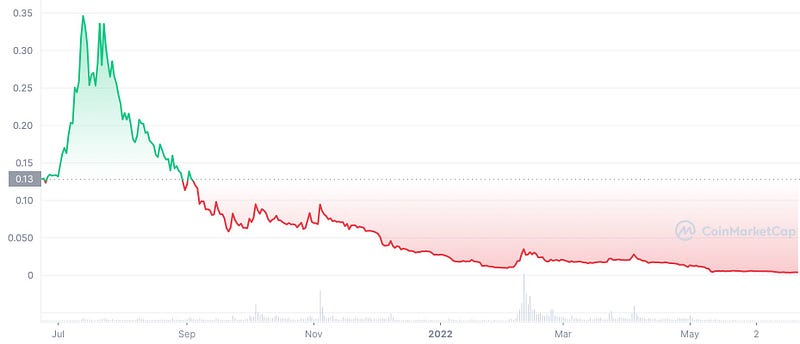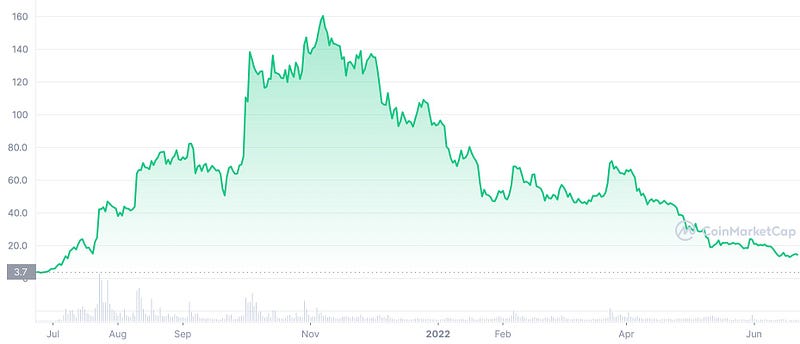
Crypto prices are falling, causing the once $3 trillion market to slip below the $1 trillion mark. With the unfurling of digital assets, many projects have been hard hit by bearish activities. Among them — the premier play-to-earn game, Axie Infinity, is on a sharp decline.
Axie Infinity is a blockchain-based gaming protocol launched by tech startup Sky Mavis in 2018, co-founded by Jeffrey Zirlin and Trung Nguyen. The P2E game was initially working on the Ethereum blockchain, but the slow transaction speed and high gas fees for verifying transactions forced the protocol to launch its own sidechain, called Ronin.
Compared to popular multiplayer games, Axie Infinity is quite simple. Players control three-member teams of digital blob-like creatures that fight one another. The characters are distinguished by their unique mixture of interchangeable body parts. During fights they just bounce in place, waiting to take turns casting spells against their opponents. When a character is defeated, it becomes a ghost; when all three squad members are gone, the team loses. A match usually takes less than five minutes.
A lot of people believed that playing to earn meant that they could actually earn a living playing Axie Infinity, and here is why. For each game players win, they get a few Smooth Love Potion (SLP) tokens and can earn another cryptocurrency, Axie Infinity Shards (AXS), in larger tournaments. The characters, known as Axies, are NFTs that can be traded like a cryptocurrency as well. Axies can also be bred: players can take two characters they already own and act as parents, paying a cost in SLP and AXS. Then after a gestation period, a new character appears with some combination of its parents’ traits that could be then sold for even more tokens. The breed-to-sell model could bring players up to 400% profit in less than a week, as new players need to own Axies before playing the game.
The crypto market witnessed a remarkable inflow of investments in 2021, and Axie Infinity enjoyed a significant player growth. The platform had over 2 million daily players logging into its website to battle. This meteoric rise saw Axie Infinity attract significant investment from crypto-focused firms like Andressen Horowitz, causing the company to hit a $10 billion valuation. Its in-game cryptocurrencies skyrocketed in value as well. SLP hit a record high of 40 cents in mid-July and AXS hit $165 in November 2021.
Axie Infinity became a huge success partially due to a form of paid labour that has long existed in gaming: the for-profit player. Players who owned Axies could rent them out to other players, usually in lower-wage regions in Southeast Asia or Latin America, who treated the game as a job. These players are widely referred to as “scholars”. According to the gaming research and consulting firm Naavik, “scholars’ in Axie’s biggest market, the Philippines, earned above minimum wage from May to October 2021. Of course, converting this income into some stable form meant cashing out their cryptocurrencies, but at that time people involved in Axie were saying these assets will only get more valuable. With the project’s ideal said to create freedom for gamers, but the scholarship system is far from being morally upright. Axie Infinity has only transitioned an existing digital feudal system into the blockchain space.
The fact that Axie was seen primarily as a way to earn money has proven to be a major problem for its virtual economy. When playing the game, you earn and spend SLP, and the tokens you spend just disappear. But those who play to earn cash out all SLP by selling them on crypto markets, meaning the total number of tokens increases over time. The additional supply depresses prices causing hyperinflation.
The unsustainability of Axie’s virtual economy is one reason that has lead to the whole thing crumbling, but then 2022 began on a bear note, and then a massive hack of Ronin network by a team of malicious attackers followed in March when the network lost $620 million in cryptocurrencies.
By March the Axie economy was deep in crisis. It had lost about 40% of its daily users, and SLP, which had traded as high as 40¢, was at 1.8¢, while AXS, which had once been worth $165, was at $56. As of the date of writing this post, things are looking even worse: SLP trades at $0.0037, AXS is worth just over $14.


Most of the players walked away with tokens worth almost nothing. And the attempt of Sky Mavis to bring back its audience by launching Axie Infinity: Origin failed. However, some still believe that Axie will pay off as an investment in the long term — that crypto gaming will inevitably take over a significant portion of the gaming world.
Since the March hack the company has been acting weird: first they announced that they were going to reimburse victims and repair the infrastructure, but in fact nothing happened. Then co-founders started giving pep-talks saying that the collective trauma of losing all that money was an opportunity to forge a stronger community. Then they hired a new head of product, Philip La, who spent the past four years as a product manager at the company behind Pokémon Go, who thinks that the game’s economy would ultimately fail if all its players continued to think like investors. And, according to the new version of the game’s white paper, Axie Infinity is a “play-and-earn”, not a “play-to-earn” game now.
Arguably, Axie Infinity is a disaster that is likely to soon see its end as it failed its players and economy model. However, there are still promising P2E projects like StepN that we described recently. Although StepN’s economy is also claimed to be unsustainable, they continue to be wildly popular and attract new audiences.
Another quick-to-rise P2E project is called Cryptokitties. These are tradable and ‘breedable’ digital pets, and extremely cute. The project surfaced in the fall of 2017, during the first crypto boom, and the digital kittens were a proof-of-concept for NFTs. Within a few months, Cryptokitties peaked, some selling for six-figure sums. Interesting fact: the founders of Sky Mavis originally met in forums for Cryptokitties.
Gods Unchained, a trading card game built on the Ethereum network, is one more example of a pretty popular P2E game. Basically, in Gods Unchained two players face off in an arena to determine who is the most powerful by using cards. These cards are NFTs that can be traded on the ImmutableX marketplace. Gods Unchained features one token on the Ethereum network, $GODS, and two in-game currencies, Flux and Stars. The price of one GODS token is $0.5, as of writing this it’s been falling since January 2022. You can make earnings from the game by simply playing it and also winning weekly tournaments.
Let’s observe and see whether something good will come out of the Axie situation in the long run, and whether or not StepN and other P2E games in question will share the same fate.
